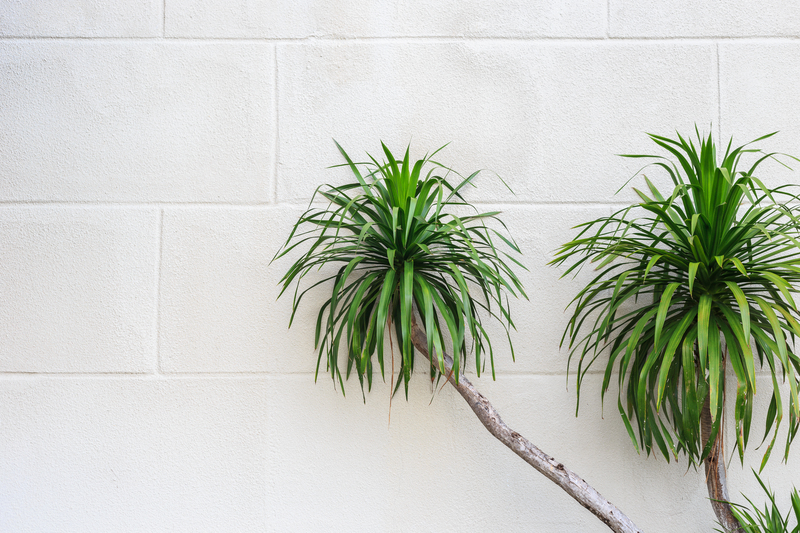Renewing Beauty in Overgrown Gardens
Posted on 29/06/2025
Renewing Beauty in Overgrown Gardens: A Comprehensive Guide
Your garden is a living space, connecting you with nature and providing endless possibilities for relaxation, entertainment, and creativity. But what happens when an oasis transforms into a wilderness? Overgrown gardens can look daunting, but with the right strategy and inspiration, you can transform tangled landscapes into vibrant sanctuaries. This ultimate guide will walk you through renewing beauty in overgrown gardens, offering expert tips and actionable steps for lasting success.

Understanding Overgrown Gardens
If your outdoor space has been neglected for a while, weeds, invasive plants, and unwanted growth can quickly take over. An overgrown garden need not be overwhelming, though. By breaking the task into manageable steps and applying the latest techniques, you'll unlock your garden's true potential.
Signs Your Garden Needs Renewal
- Dense Weed Growth choking out cherished plants and flowers
- Unruly Lawns with moss, tall grasses, and spiky patches
- Lost Paths and Borders hidden beneath unchecked growth
- Out-of-Control Shrubs and Trees overshadowing the landscape
- Damaged Structures such as garden beds, fences, and pergolas
Recognizing these signs is the first step toward restoring overgrown gardens.
Why Restore an Overgrown Garden?
Renewing the beauty of neglected gardens offers a host of benefits:
- Enhanced Curb Appeal: A tidy, flourishing garden improves property value and neighborhood appeal.
- Personal Satisfaction: Witnessing the transformation provides immense pride.
- Environmental Health: Managed green spaces support biodiversity, pollinators, and soil quality.
- Functional Use: Reclaim outdoor space for entertainment, play, and relaxation.
- Mental Well-Being: Gardening reduces stress and fosters a sense of well-being.
Step-by-Step Plan for Garden Renewal
Step 1: Assessment and Vision
Before diving into the hard work, spend time assessing your garden's condition. Walk through the area and make notes:
- What plants are thriving and which are struggling?
- Are there hidden gems - mature shrubs, unique trees, promising perennials?
- Where are the problem zones: dense weeds, tangled borders, or shaded areas?
- What features would you like to add or revive? (e.g., patios, pathways, water features)
Sketch your vision. Even a simple rough map helps solidify your goals for restoring a neglected garden.
Step 2: Safety First
Overgrown gardens can harbor hazards like uneven ground, thorny brambles, or hidden debris. Equip yourself with:
- Gloves and sturdy boots
- Protective clothing
- Sharp, clean tools (pruners, shears, spades)
- Sun protection (hat, sunscreen)
Step 3: Clearing and Cleaning
The real transformation begins with removing unwanted growth and debris:
- Start at the edges: Work along pathways, borders, and entrances first.
- Tackle weeds and invasive species: Remove roots to prevent regrowth; consider eco-friendly weed suppressants.
- Trim back shrubs and trees: Cut away dead, diseased, or overcrowded branches. Thinning allows light and air back in.
- Remove dead plants and waste: Bag up or compost viable green waste, but discard disease-prone matter safely.
- Restore lawn and soil: Rake, mow, and aerate stubborn patches.
As you clear, watch for precious plants to preserve, and uncover forgotten features worth saving.
Rejuvenating Garden Features
Saving and Restoring Hardscape
Paths, patios, walls, and garden furniture can become invisible beneath vegetation. Carefully uncover and assess their condition:
- Pressure-wash or scrub patios and paths to remove moss and dirt.
- Repair or replace broken stones, bricks, or timber edging.
- Repaint or sand wooden benches and trellises.
- Upgrade features like lighting or water elements for renewed charm.
Restoring Borders and Beds
Borders are the heart of a garden's design. For renewing overgrown beds:
- Mark bed edges: Rediscover and redefine using a spade or lawn edger.
- Amend soil: Add compost or organic matter to revive fertility.
- Divide and transplant perennials: Old clumps respond well to division, providing more plants and better blooms.
Choosing Plants for a Revitalized Garden
What to Keep and What to Remove
Evaluate existing plants with a critical eye. Retain mature trees and established shrubs with good structure, even if they need reshaping. Discard:
- Weedy species or aggressors crowding out other plants
- Unhealthy or diseased plants beyond recovery
- Any plants that do not suit your renewed garden's style
Adding New Life to Your Garden
Enhance your newly cleared spaces with a thoughtful mix of plants:
- Native species: These are resilient, support local wildlife, and require less upkeep.
- Layered planting: Combine trees, shrubs, perennials, bulbs, and groundcovers for depth and visual interest.
- Year-round appeal: Add evergreens, winter bark, and seasonal blooms for all-season beauty.
- Color and texture: Choose plants with striking foliage, unique forms, and vibrant flowers.
Popular Choices for Renewed Gardens
- Lavender and rosemary for fragrance and pollinators
- Hostas, ferns, and shade-loving perennials for under trees
- Hardy ornamental grasses for movement and low-maintenance beauty
- Bulbs like daffodils and tulips for spring impact
- Small flowering trees, such as crabapple or dogwood, for structure
Design Tips for Lasting Beauty
Creating Functional Spaces
Think about how you want to use your garden. Functionality is just as important as beauty when reviving an overgrown landscape:
- Lawn areas for playing, relaxing, or entertaining
- Pathways for easy navigation and flow
- Shaded seating spots for summer afternoons
- Wildlife corners with bug hotels, bird feeders, or ponds
- Herb or vegetable beds for a kitchen garden boost
Layering and Plant Combinations
For a lush, cohesive look, layer plants by height and seasonality. Group in drifts and repeat combinations for unity. Mix flowering, foliage, and structural plants so that the garden stays interesting even when not in bloom.
Low-Maintenance Solutions
- Mulch beds to retain moisture and suppress new weeds.
- Install drip irrigation to save water and time.
- Choose drought-tolerant and disease-resistant plants for long-term health.
- Use groundcovers to fill gaps and reduce bare soil.
Ongoing Care: Keeping Your Garden Beautiful
Renewing beauty in overgrown gardens is not a one-time achievement. Follow these steps for ongoing success:
- Regular weeding to prevent a return to chaos.
- Seasonal pruning for healthy, attractive shrubs and trees.
- Feeding and mulching annually to keep the soil nutritious.
- Inspecting for pests and diseases and acting quickly when found.
- Reworking and redesigning as your tastes or garden needs change.
Pro Tips for Long-Term Garden Care
- Keep a monthly checklist to stay on top of tasks.
- Record plant names and care notes in a garden journal.
- Celebrate progress by photographing before and after scenes.
FAQ: Renewing Beauty in Overgrown Gardens
How long will it take to restore my overgrown garden?
Time varies with the garden's size and condition. Small spaces can be transformed in a weekend, while larger or more neglected plots may need weeks or months. Break big projects into smaller stages for steady motivation and progress.
Do I need to remove all existing plants?
No - focus on preserving healthy, well-placed, and mature specimens. Removing only weedy or unhealthy plants allows your garden's history and personality to shine through.
What if I'm overwhelmed?
Start with a single section. Enlist family, friends, or professional gardeners as needed. A gradual approach is often more manageable and enjoyable.
Which tools do I need?
Essentials include sturdy pruners, shears, a spade or digging fork, gloves, wheelbarrow, and a rake. For larger jobs, consider hiring or borrowing a brush cutter or strimmer.
How can I prevent future overgrowth?
Routine maintenance is key. Mulch suppresses weeds, while regular mowing, pruning, and monitoring keeps growth in check. Consider landscaping fabric under beds or paths for harder-to-manage areas.

Final Thoughts: Embrace the Renewal Journey
Renewing an overgrown garden isn't just about hard work - it's an act of creativity, nurturing, and personal expression. Every pair of pruned branches and weeded bed breathes new life into your landscape. With ongoing care, smart design, and thoughtful planting, your garden will thrive, offering renewed beauty for years to come. Don't let the wildness dismay you; embrace the process and uncover the unique potential that lies beneath.
If you're ready to begin restoring the natural charm of your outdoor sanctuary, start today with these steps. A vibrant, flourishing garden is closer than you think!
Related Resources
- Royal Horticultural Society: Renovating Neglected Gardens
- BBC Gardeners' World: Rescue an Overgrown Garden
- The Spruce: How to Restore a Neglected Garden
Renewing beauty in overgrown gardens is a journey that can transform not only a tangled yard, but your connection with nature itself. Happy gardening!

